After almost having been lost in Britain, Red Kite is an increasingly familiar sight across the country – a real conservation success. However, identification can be made trickier by the much rarer Black Kite. The very unfamiliarity of the latter means that it could be overlooked, especially with distant views. The outlying possibility of both Asian and African subspecies, plus hybrids, further complicates the picture. Dick Forsman offers all the advice you need to confidently recognise these species in all plumages.
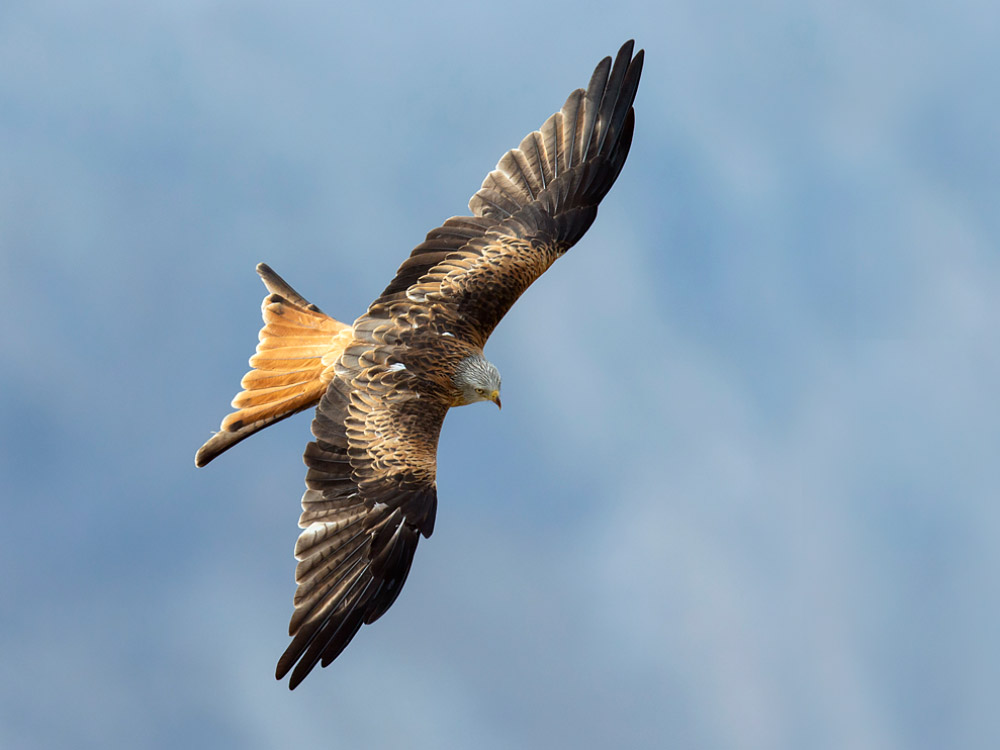
Adult Red Kite (Pyrenees, Spain, 1 November 2017). This bird is showing the typical upperparts of adult Red Kite, with a bright cinnamon and deeply forked tail, contrasting light head and dark upperwings, except for the distinctly marked rufous coverts (Dick Forsman).
Europe has two species of Milvus kites: Red Kite and Black Kite. In Britain the former is an increasing resident, while Black is a rare visitor, mostly seen in spring and autumn. In a wider context, Red Kite is a western, typically European species, while Black has a huge range extending across the entire Palaearctic region from the Atlantic to the Pacific Ocean.
Although the two are quite different, misidentifications do occur. Plumage-wise Red Kite is the less variable of the two, as there is little individual or geographical variation. In Black Kite, however, both individual and geographical variation are extensive. Getting to grips with this variation is one of the keys to safely separating the two species.
Geographical variation
Red Kite looks the same across its entire range from Scandinavia to the Mediterranean. Once you familiarise yourself with the juvenile and adult plumages of the species, that knowledge will apply to all birds anywhere in Europe.
However, several Black Kite forms are found within the boundaries of the Western Palaearctic. European birds are the nominate migrans, also called Western Black Kite, whereas Far Eastern birds from China and Japan are lineatus, known as Black-eared Kite, which is regarded by some as a full species.
Between Black and Black-eared Kites is a wide transition zone, from Russia to Mongolia and western China, where these two forms interbreed, resulting in a recognisable hybrid form: Eastern Black Kite. In addition to these forms the Indian subcontinent has its own resident Black Kite subspecies, govinda, and in Australia and Indonesia the local subspecies is affinis.
The two African forms aegyptius and parasitus were until recently regarded as subspecies of Black Kite, but are now widely recognised as constituting a separate species, Yellow-billed Kite.
Migration patterns
Red Kite is largely resident over much of its range, but Scandinavian birds, immatures in particular, do leave their breeding grounds and move to southern Europe for the winter. Black Kites, on the contrary, are strongly migratory.
European birds start to leave from July-August, when thousands are counted in southern Spain crossing to Africa. These birds winter in West Africa, with high numbers recorded in the Sahel, along the southern fringes of the Saharan desert.
More easterly populations take the eastern fly-way through the Middle East, ending up in sub-Saharan East Africa. More recently, numbers of birds wintering in the Near East, for instance in Israel, have rocketed.
As a rule of thumb most Black Kites have left Europe by the end of September, while the hybrid Eastern Black Kite, common in the Levant and the Middle East, is a later migrant and wintering numbers start to build up during late September and October. This is also when these rather diagnostic-looking birds can be seen further west in Europe, often causing heated discussions about the possibility of Black-eared Kite.
The Far Eastern subspecies lineatus has not yet been recorded in Europe, and all the look-alikes seen well enough have been Eastern Black Kites. Even most of the wintering birds as far east as Arabia and India show a mix of characters from migrans and lineatus and are thus best referred to as Eastern Black Kites. Very few individuals tick all the boxes to be regarded as pure Black-eared Kites.
Body proportions
These are medium-sized raptors, differing from the well-known buzzard shape by their long wings and tails. Compared to a buzzard, flight is elegant and the movements slow and gentle, owing to the long wings and relatively low wing loading (the bird's weight in relation to its wing surface area).
Red Kite has long, narrow and flexible wings and a very long and deeply forked tail; its active flight is one of the most graceful of all our raptors. Black Kite has slightly broader wings comparatively and the tail is shorter, which makes the flight appear less elegant.
Both species have very short legs both for their body size and compared with most other raptors, which gives them a very special jizz when perched. The feet seem to be attached quite high up on the body, with a major part of the bird trailing behind and 'hanging' below the perch.
At rest, Red and Black Kites can often be told from one another by the silhouette. The very long tail of the former protrudes well beyond the wing-tips, while in Black Kite the tail and wing-tips fall more equally. However, it is worth remembering that first-year Red Kites are shorter tailed than adults.
Distant birds
When identifying distant kites, where plumage characters cannot be evaluated, the different silhouettes of the two species are important. Red Kite has very long, narrow wings which, when soaring, are pressed well forward. The outer wing, the 'hand', appears to be narrower than the arm, the 'fingers' are long and the tip is narrow and rounded. The tail is very long, with a narrow base and pointed corners. All this creates a silhouette which is one of the most elegant of all European raptors.
By comparison Black Kite's wings are slightly broader, more rectangular and the wing-tip is more square cut. The tail is also shorter and less clearly forked, often with no visible fork at all.
Juvenile Red Kites have a less extreme shape compared to adults and could be a potential pitfall. The wings are somewhat shorter – therefore appearing broader – and the tail is shorter with a shallower fork. Although more compact than the adult, first-year Red Kite still appears longer winged and longer tailed than any Black Kite.
Close up
When birds are seen close enough to discern plumage tones, identification should be straightforward. Red Kite is a colourful and contrasting mix of bright rufous, cinnamon, black and white, while Black Kite appears uniform and dull by comparison.
Red Kite's underwing window on the primaries is bright white, and only thinly and indistinctly barred; it reaches the trailing edge of the wing and is sharply set against the dark secondaries. In Black Kite the window is poorly defined, typically just a shade lighter grey than the rest of the underwing, and is coarsely yet diffusely barred.
Eastern Black and Black-eared Kites can be a bit more challenging, as they often show some clear white markings in the underwing primaries, but the primary window is always coarsely barred and irregularly shaped, never all white to the edges as in Red Kite.
Adult Yellow-billed Kite is often even more uniform on the underwing than Black Kite, but is often recognised by being clearly rufous overall. At close range the all-yellow bill of the adults is a giveaway, but dark-billed juveniles can be extremely similar to juvenile Black Kite, which may share the same range in winter. Although the juveniles may be almost identical in plumage, the breeding seasons of Yellow-billed and Black differ, leading to differences in the timing of moult and plumage wear, which can be a useful clue when identifying Milvus kites in Africa.
Wing formula
Red Kite is quite unique in showing only five long, fingered primaries, with the sixth (counting inwards) being short and falling more or less in line with the trailing edge of the hand. Black Kite is more variable, as the wing formula differs between subspecies.
Black Kite has five well-fingered primaries, with the sixth being clearly shorter, often protruding as a separate but shorter finger. This makes the outer wing look both broader and blunter compared to Red Kite. Black-eared Kite has the broadest wing-tip of all, with six deeply fingered primaries in the wing-tip, with the innermost sixth finger long and pointed and well protruding. Eastern Black Kite is intermediate, often showing a well-formed and protruding sixth finger, longer and more prominent compared to the average Black Kite. The Yellow-billed Kites of Africa only have five deeply splayed fingers, while the sixth is the shortest compared to any form of Black Kite.
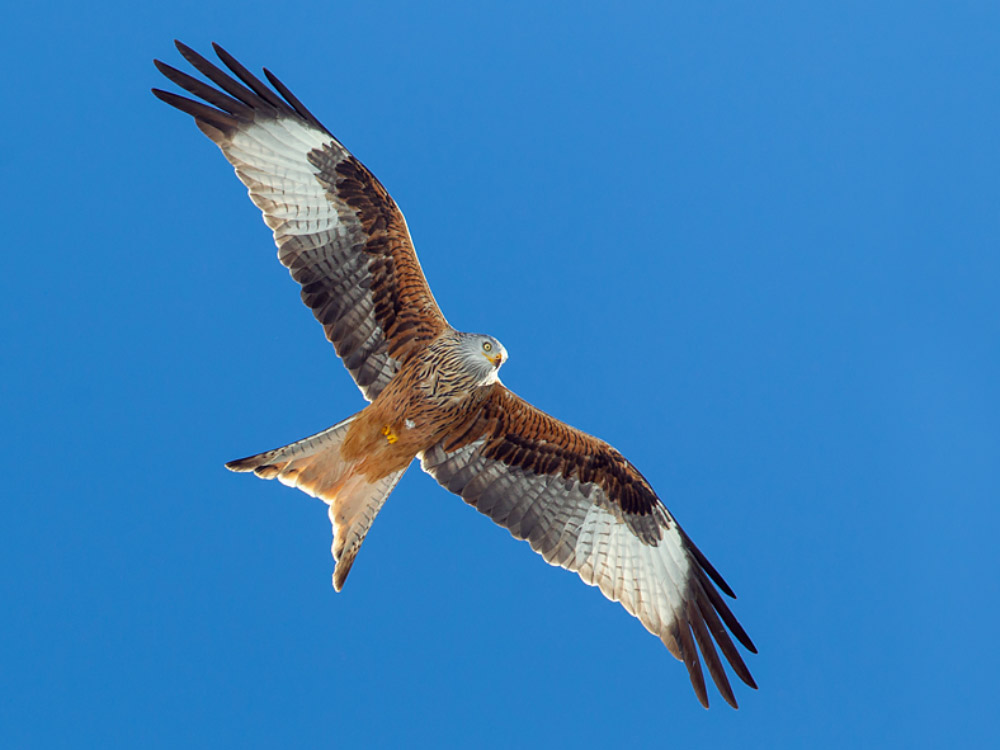
Adult Red Kite (Pyrenees, Spain, 23 November 2010). All the diagnostic features of the underparts of adult Red Kite can be seen here: deep rusty brown coloration, a distinctly framed clean white primary window reaching the trailing edge of the wing, a light and translucent deeply forked and light cinnamon-coloured tail, a marked contrast between the reddish forewing and dark mid-wing band, and broad black streaking on the chest. Note also the five long black fingers of the wing-tip (Dick Forsman).
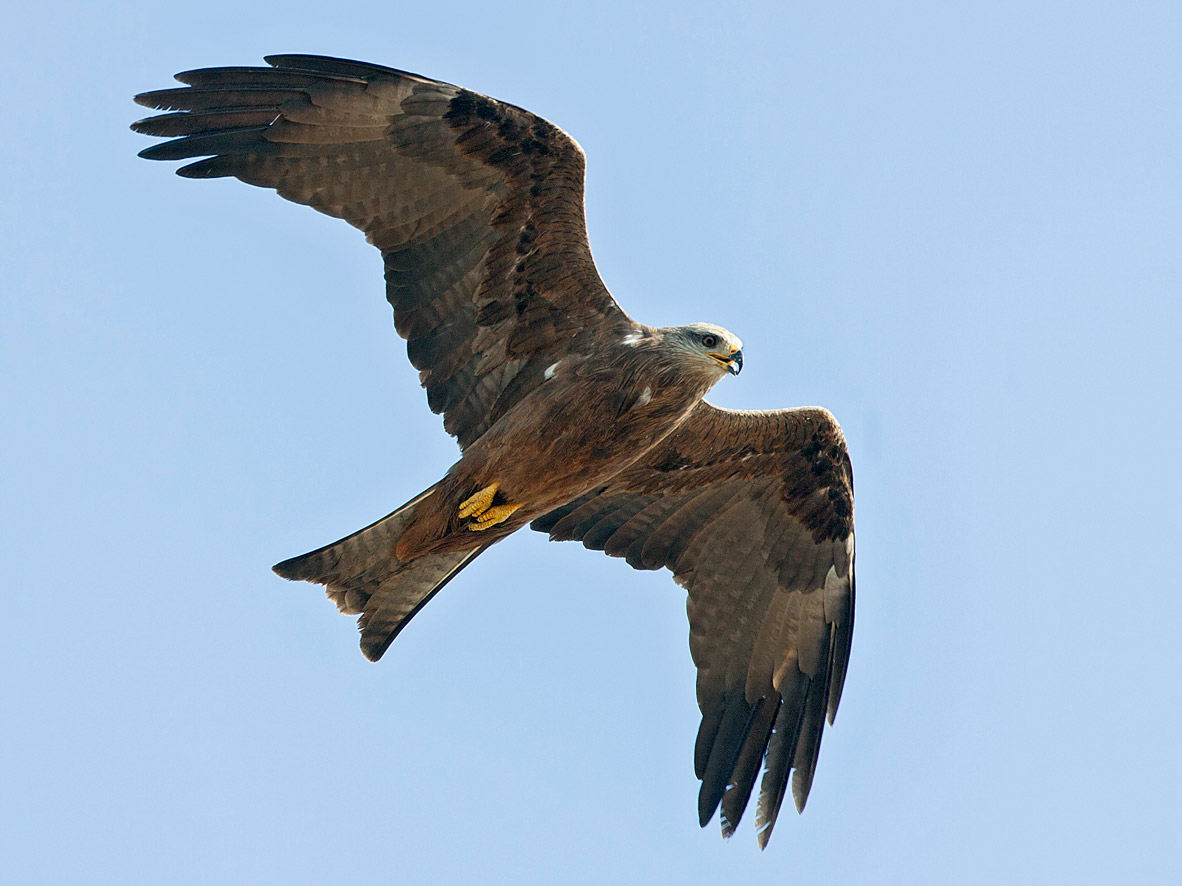
Adult Black Kite (Galilee, Israel, 5 October 2009). Adult Black Kites appear rather uniform below, lacking any contrasting colours. The underwing has no strong contrasts, looking uniformly dark when seen from a distance. The somewhat lighter primary window shows only barely visible diffuse darker barring. The grey head and light iris, as seen here, are typical of older adults but take years to develop. The feet and cere are bright yellow in all age classes, which is of importance when comparing with more eastern forms of Black Kite (Dick Forsman).
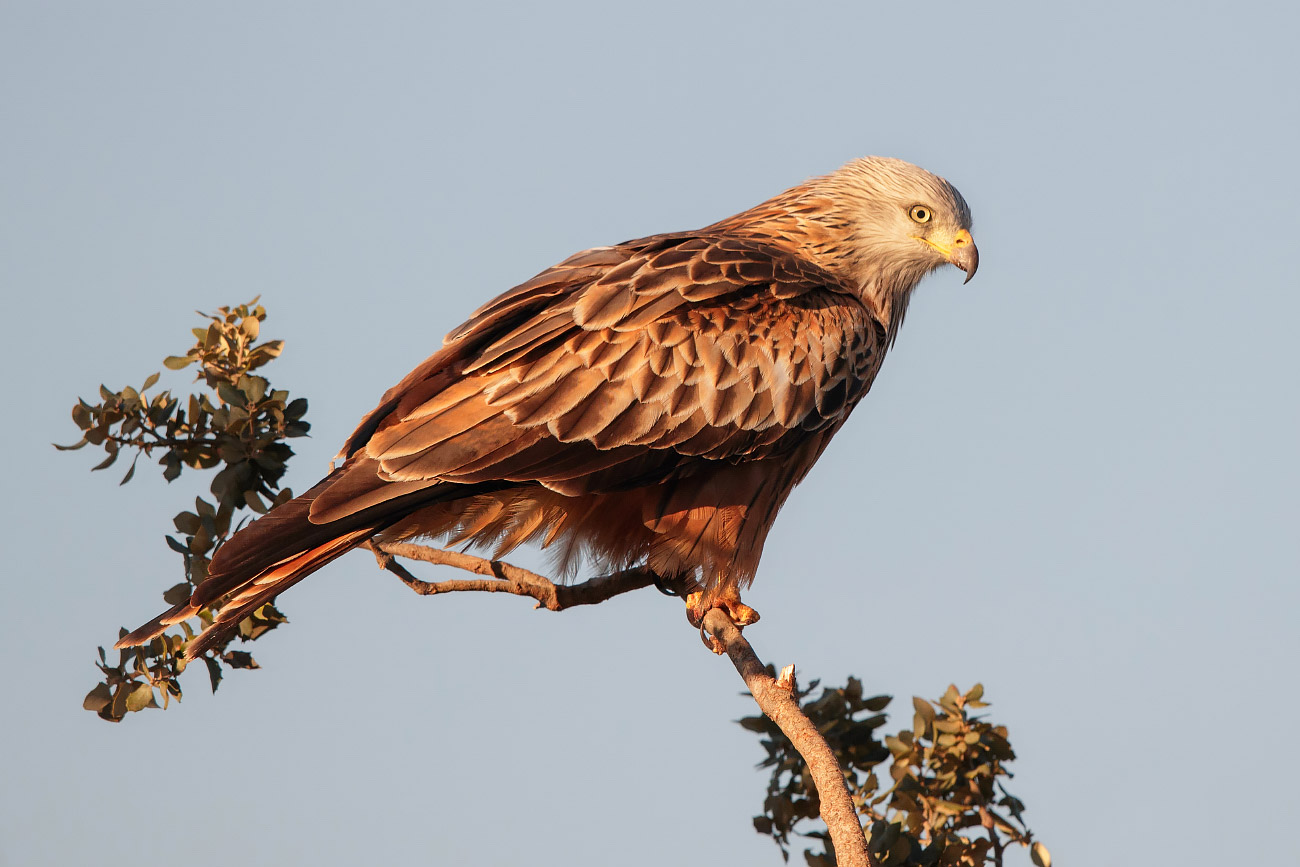
Adult Red Kite (Extremadura, Spain, 1 December 2017). Note the almost white head and iris, as well as the distinctly marked, black-centred upperwing coverts of this bird, all diagnostic characters of adult Red Kite. The wing-tips fall clearly short of the tail-tip, which is a good structural difference from Black Kite (Arie Ouwerkerk / www.agami.nl).
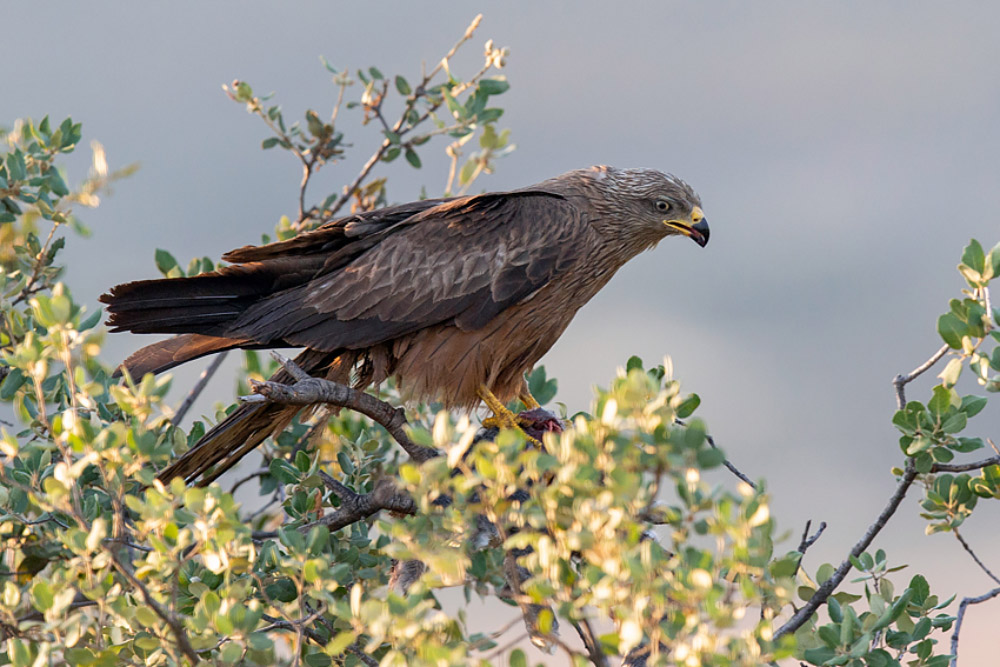
Adult Black Kite (Extremadura, Spain, 26 June 2015). The head is grey with dark streaking and the iris is light in older adult Black Kite. Note the rather uniform upperwing coverts and the lack of bright rufous-colour tones below and compare with Red Kite (Dick Forsman).
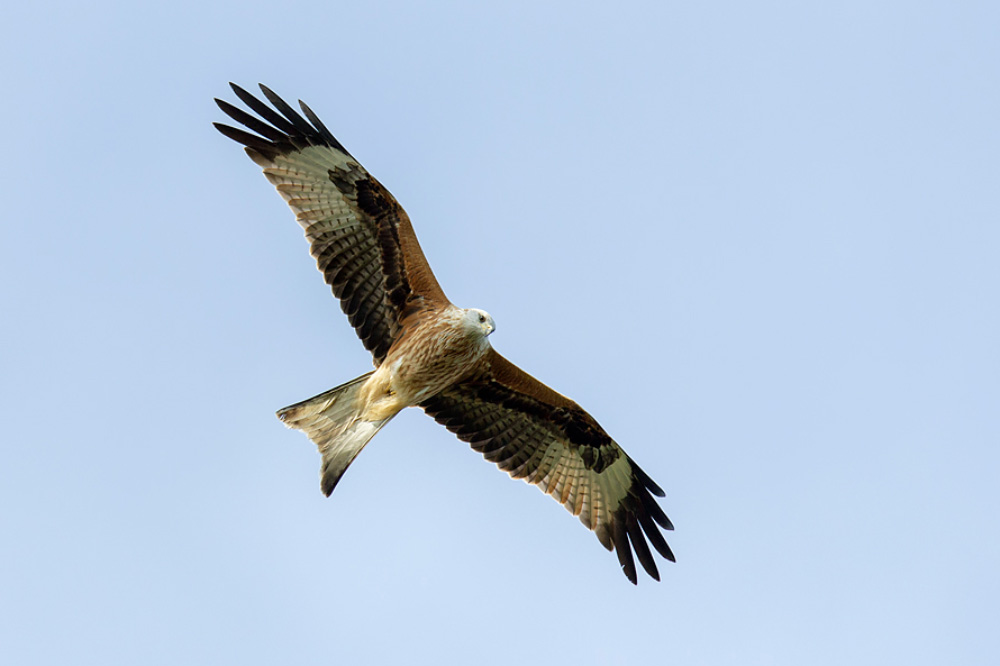
Juvenile Red Kite (Falsterbo, Sweden, 30 September 2017). Juvenile Red Kites are slightly less extreme in silhouette compared to adults, with comparatively shorter wings and tail. The white primary window is similar to adults, but the underbody streaking is pale and the colour contrast between the lighter russet forearm and the dark mid-wing band is often more striking in juveniles. Note also the very light vent and undertail coverts, which differ from more warmly plumaged adults (Dick Forsman).
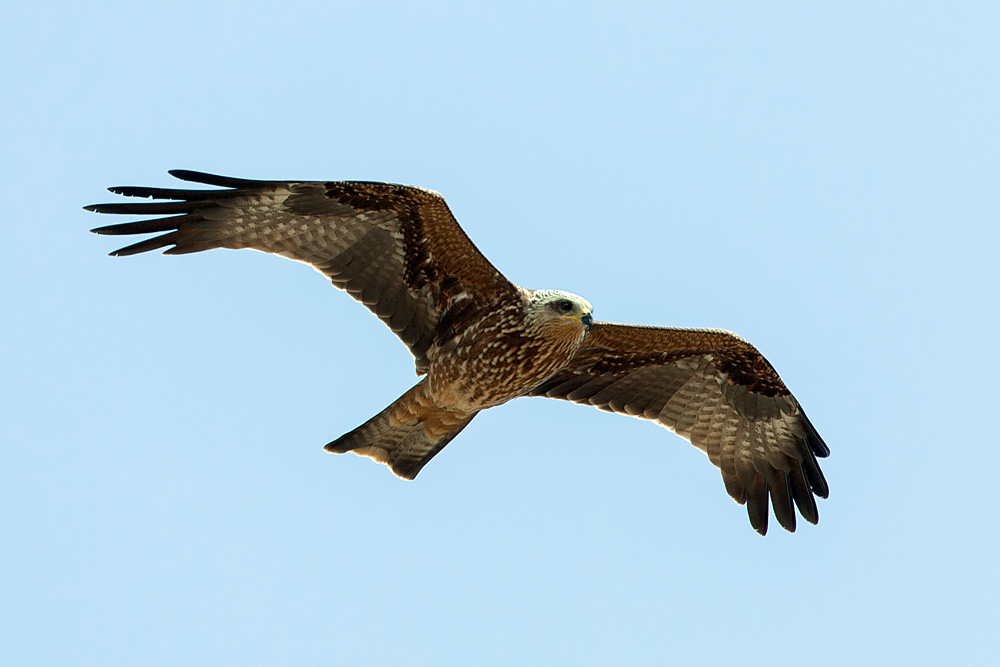
Juvenile Black Kite (Andalucia, Spain, 15 September 2005). Juveniles of this species are distinctly marked compared to adults, with light spots all over in fresh plumage. They also have a creamy head with a dark eye-mask, but all these features will wear off during the first winter, making the young birds more similar to adults by spring. Compared to Red Kite, note in addition to the overall darker and duller colours the greyish and coarsely barred primary window and the darker and barred tail. Young Black Kites always have dark eyes, which differs from both Red Kite and older Black Kite (Dick Forsman).
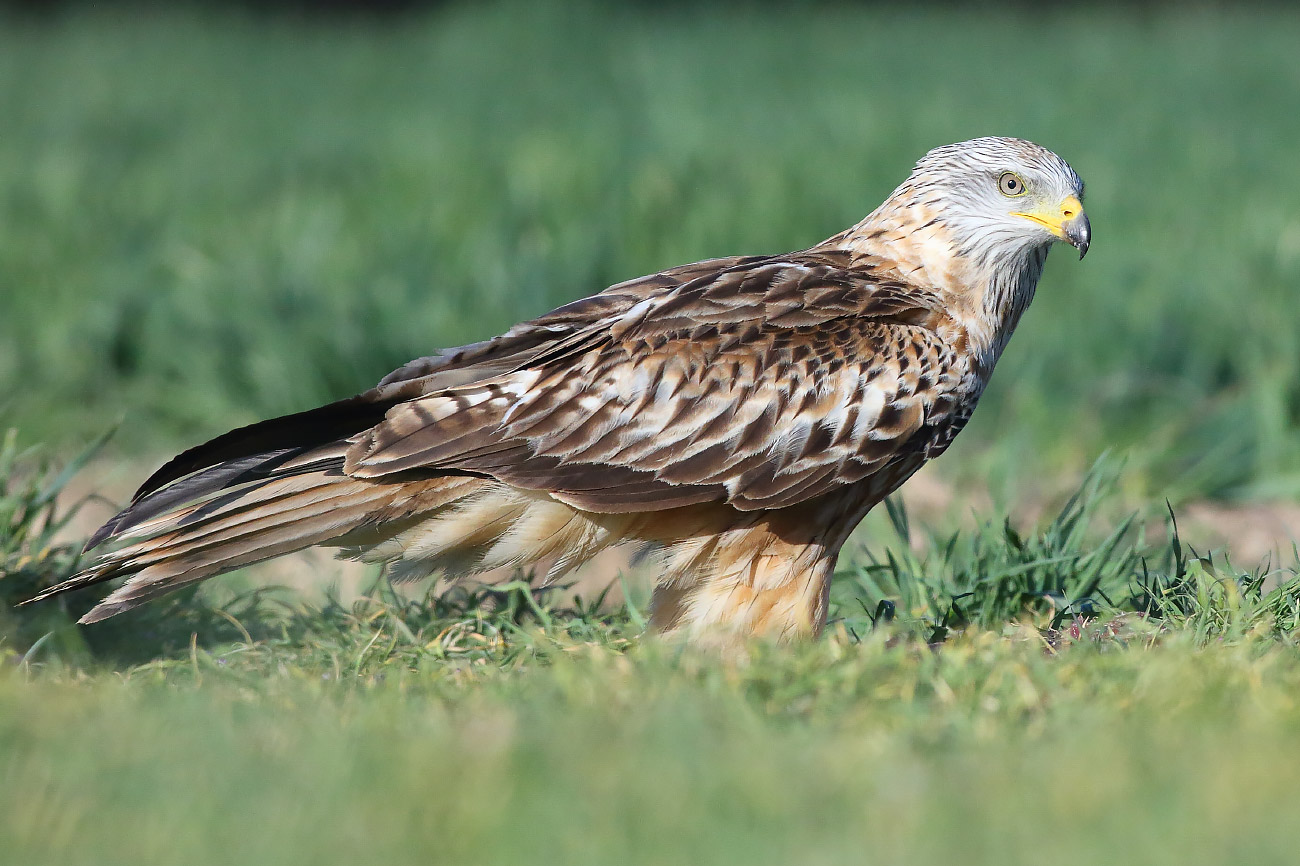
Juvenile Red Kite (Segovia, Spain, 8 April 2015). By spring juvenile Red Kites appear rather worn above and the bright colours have faded since autumn, but they can still be aged by the light undertail coverts and 'trousers' and their rather drab tail colour and worn upperwing coverts. Even in young Red Kites, with shorter tails than the adults, the tail projects beyond the wings, maintaining a useful structural distinction from Black Kite at all ages (Carlos Bocos).
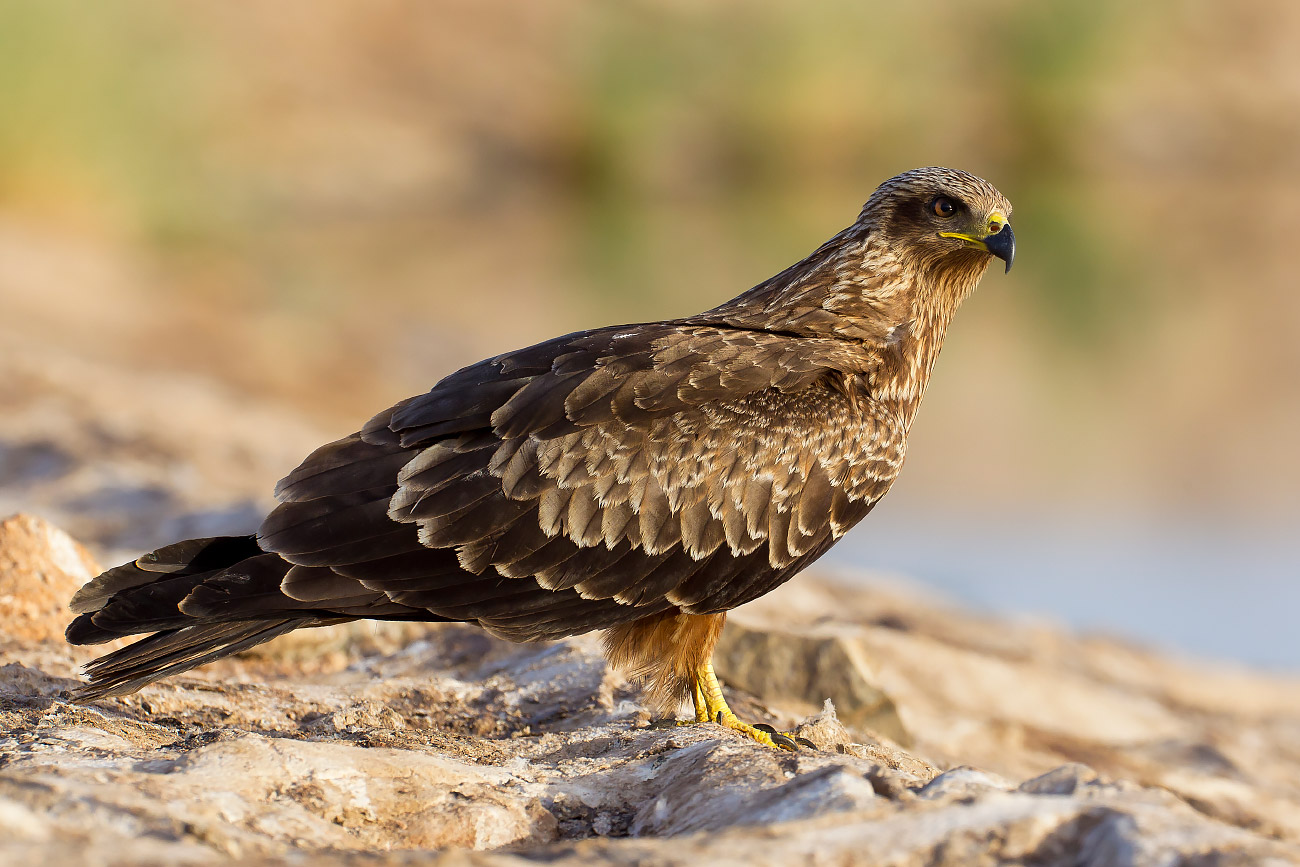
Juvenile Black Kite (Sharm El Sheikh, Egypt, 19 November 2010). In fresh plumage autumn juvenile Black Kite is a handsome bird. It is duller and more uniform in colour compared to young Red Kite and the lighter median upperwing coverts lack the contrasting black centres of the latter. The upperparts are beautifully spotted with light feather tips, while the head and breast show distinct pale streaking. By spring the light spots wear off and the general aspect is uniformly dull brown and much more adult-like. Note the dark brown iris of juvenile Black Kite, a good feature compared to any Red Kite, while the bill is truly black and contrasts sharply with the yellow cere at all ages. On perched juveniles the tail-tips and wing-tips are almost level (Daniele Occhiato / www.agami.nl).
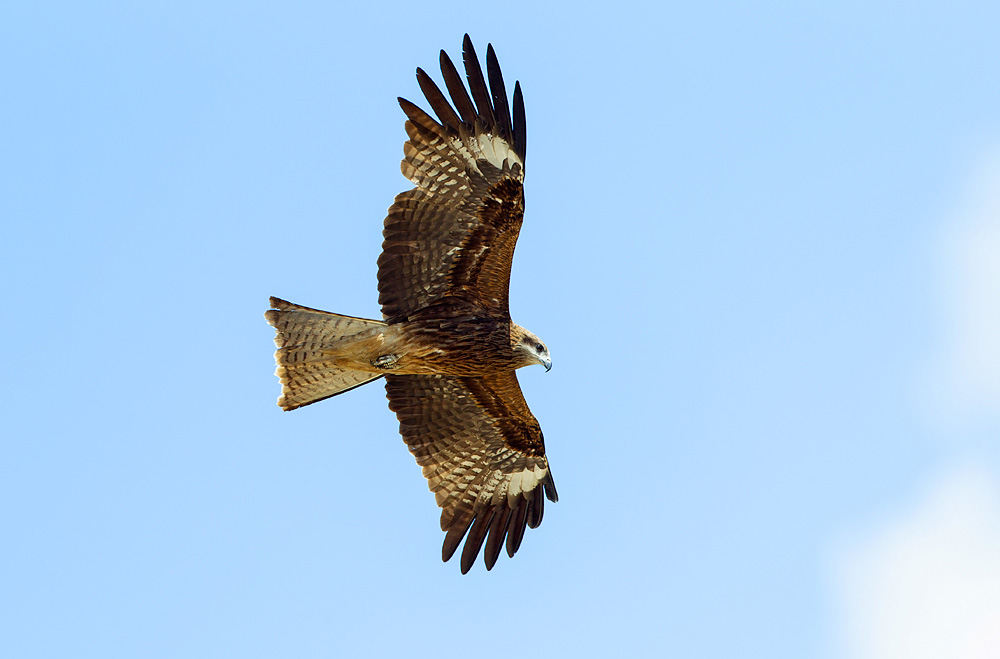
Adult Black-eared Kite (Mongolia, 5 June 2012). Black-eared Kite is a big, chunky bird with broad wings and six deeply splayed fingers, almost eagle-like in silhouette. It differs from Black Kite in several ways, the best being – apart from the different wing formula with its white-based outer primaries and distinct primary barring – that adults have a brown head with a white throat and face, while the iris remains dark. Importantly, the cere and feet are pale bluish or dirty white in all age classes, not yellow as in all other Black Kite forms. Eastern Black Kite can look very similar, but shows yellowish feet and cere and develops a paler iris as an adult (Dick Forsman).
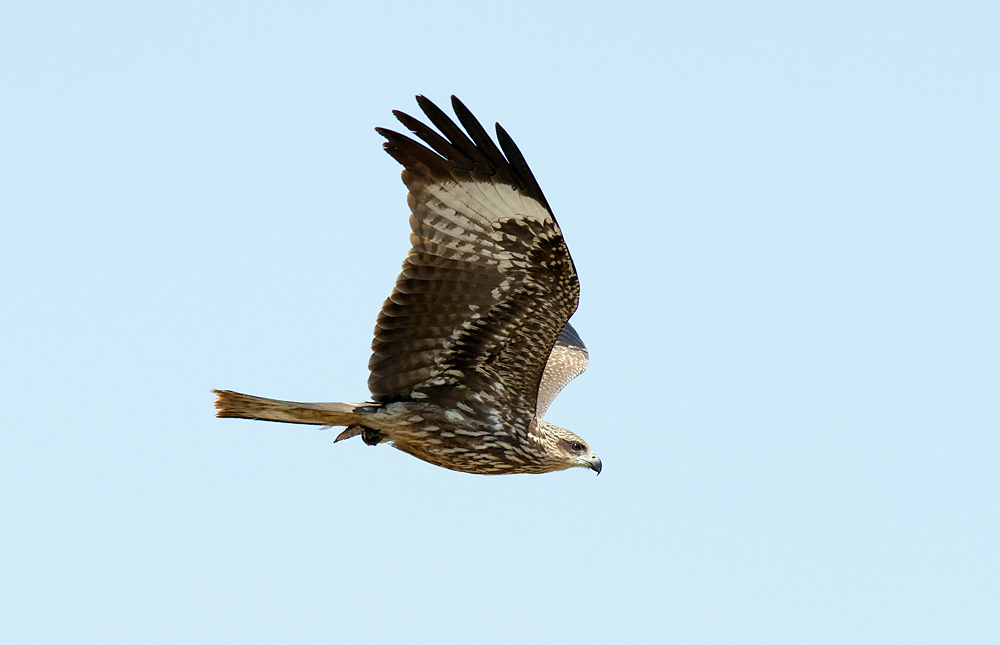
Juvenile Eastern Black Kite (Rift Valley, Ethiopia, 18 November 2011). The hybrid form between Black and Black-eared Kite, Eastern Black Kite is very similar to Black-eared, but the cere and feet show an individually variable yellow colour, which is not possible to assess from this image. The plumage of this juvenile from East Africa is very similar to that of a juvenile Black-eared Kite; apart from the yellowish cere and feet, only minor structural differences and the streaked rather than uniformly pale belly reveal it is in fact a bird from the hybrid zone (Dick Forsman).
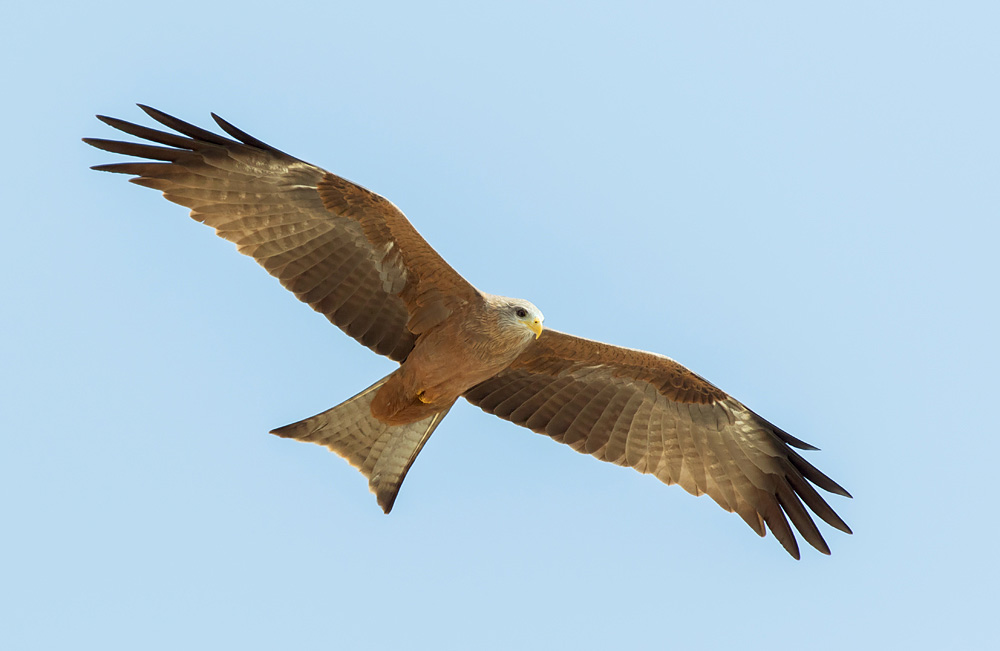
Adult Yellow-billed Kite (Cape Coast, Ghana, 26 November 2015). The African form of Black Kite is easily identified by the all-yellow bill, not just the cere, while the plumage is uniformly coloured, often clearly rufous, and lacking any contrasting markings. The wing-tip shows five long and fingered primaries, with the sixth much shorter and normally not protruding from the trailing edge of the wing. The tail of adults appears more clearly forked compared with adult Black Kite, but juveniles of both forms show less forked tails. The iris remains brown in Yellow-billed Kite. Juvenile birds can be difficult to tell from juvenile Black – the slightly different wing formula is one of the better features to go by. The bill colour in Yellow-billed is dark in young birds but gets gradually paler during the first two years, whereas it remains black with a contrasting yellow cere in Black (Dick Forsman).
- This article was originally published in the April 2019 issue of Birdwatch magazine.



